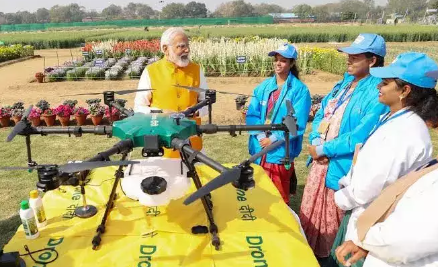Namo Drone Didi Scheme (GS Paper 2, Government Policies)

In the News
- The Government of India has unveiled the operational guidelines for the Namo Drone Didi Scheme, an initiative aimed at empowering rural women and modernizing agriculture.
- The scheme, which falls under the Deendayal Antyodaya Yojana – National Rural Livelihood Mission (DAY-NRLM), will provide women Self-Help Groups (SHGs) with drones to offer rental services for agricultural tasks.
- The initiative, scheduled to run from 2024 to 2026, seeks to support 14,500 SHGs across the country.
About the Namo Drone Didi Scheme
- Type: Central Sector Scheme, part of the DAY-NRLM initiative.
- Objective: The scheme's primary goal is to empower women by integrating technology into agriculture. It will enable SHGs to rent out drones for various agricultural tasks, helping improve farming efficiency and productivity.
- Ministry Involved: Ministry of Agriculture & Farmers Welfare.
- Governance: The Central Empowered Committee, comprising secretaries from key departments, will oversee the scheme, while Lead Fertilizer Companies (LFCs) will handle implementation at the state level.
Key Features of the Scheme
- Financial Assistance:
- SHGs will receive 80% subsidy (up to ₹8 lakh) for purchasing drones.
- Additionally, the scheme offers financing options through the Agriculture Infra Financing Facility (AIF), with a 3% interest subvention on loans.
- Drone Packages:
- Each drone package will include key accessories such as spray assemblies, cameras, batteries, chargers, and measurement tools.
- The packages will also come with extra batteries and propellers, enabling coverage of up to 20 acres per day.
- Training Programs:
- Each SHG will appoint a drone pilot who will undergo a 15-day training in drone operation and its use for agricultural tasks like nutrient spraying, pesticide application, and more.
- Implementation and Oversight:
- The scheme will be coordinated by Lead Fertilizer Companies (LFCs) in collaboration with state departments, drone manufacturers, and SHG federations.
- An IT-based Drone Portal will facilitate end-to-end monitoring, fund disbursement, and real-time tracking of drone usage.
Significance of the Namo Drone Didi Scheme
- Empowering Women:
- The scheme provides income-generating opportunities for women in rural areas, enabling them to run drone services and become key players in the modernization of agriculture.
- Modernizing Agriculture:
- The use of drones for fertilizer spraying, pesticide application, and crop monitoring is expected to boost crop yield and productivity, bringing advanced technology to rural areas.
- Reducing Costs for Farmers:
- Drones help save time and labor in agricultural tasks, making high-tech farming practices more affordable and accessible to small-scale farmers.
- Promoting Skill Development:
- The scheme offers a platform for rural skill development, training SHG members in drone operations, maintenance, and the broader application of digital technologies in farming.
- Supporting Government Initiatives:
- Aligning with the DAY-NRLM and the Kisan Drones initiative, the scheme reinforces the government’s broader agenda of rural empowerment and sustainable agricultural practices.
- Enhancing Technological Access:
- The introduction of drones brings cutting-edge technology to rural communities, promoting digital inclusion and reducing the technology gap in India's agricultural sector.
Challenges and Concerns
- Financial Burden on SHGs:
- While the scheme offers a subsidy of 80%, the remaining 20% must be covered by loans. This could place a significant financial burden on financially vulnerable SHGs, especially if the economic returns from drone services do not meet expectations.
- Limited Training for Technical Complexity:
- The 15-day training program may not be adequate for SHG members to fully grasp the complexities of drone operations, especially in tasks like pesticide spraying, which requires technical precision and understanding of safety protocols.
- Bureaucratic Inefficiencies:
- The scheme's implementation depends heavily on Lead Fertilizer Companies (LFCs), which could introduce bureaucratic delays and inefficiencies. This might slow down the rollout and affect its impact on SHGs and farmers.
- Environmental and Health Risks:
- There are concerns about the environmental impact of drone spraying, particularly in ecologically sensitive areas. Conservationists have raised alarms that aerial pesticide spraying could negatively affect pollinators, such as bees, and disrupt fragile ecosystems, as seen in regions like the Nilgiris in Tamil Nadu.
Way Ahead: Recommendations
- Enhanced Financial Support:
- To alleviate the financial burden on SHGs, the government could explore grant-based financial support or subsidies for the remaining 20% of the drone cost, reducing the dependence on loans and minimizing financial strain.
- Extended Training Programs:
- The 15-day training program should be extended and include refresher courses to ensure SHG members are well-equipped to handle technical challenges, including troubleshooting and emergency procedures.
- Environmental Safeguards:
- Clear guidelines for safe pesticide spraying should be established, especially in sensitive areas, to prevent harm to biodiversity and mitigate risks to human health. This should include restrictions on drone operations near protected ecosystems and clear operational guidelines for sustainable drone use in agriculture.
- Improved Implementation Mechanisms:
- To reduce bureaucratic inefficiencies, a more streamlined coordination model could be developed, perhaps involving local government bodies and community leaders to ensure faster and more effective implementation of the scheme.
Conclusion
- The Namo Drone Didi Scheme is a groundbreaking initiative that seeks to empower rural women, modernize Indian agriculture, and improve productivity through drone technology.
- While the scheme offers significant potential for positive change, it faces challenges related to financial accessibility, technical training, and environmental impacts.
- Addressing these concerns will be crucial to ensuring the success and sustainability of the initiative, making it a truly transformative tool for rural empowerment and agricultural development in India.


